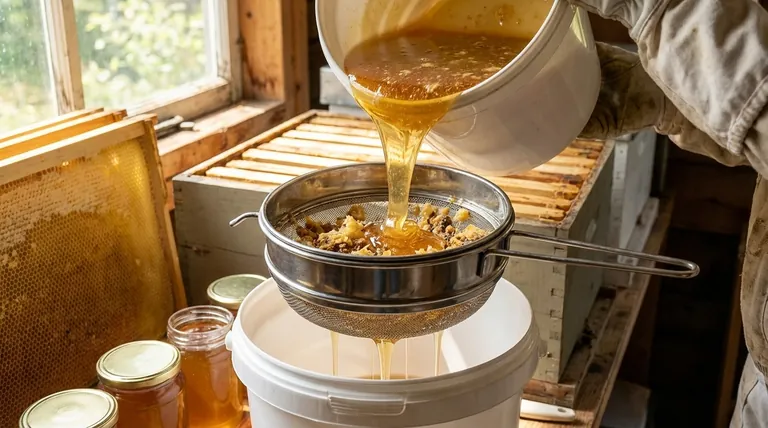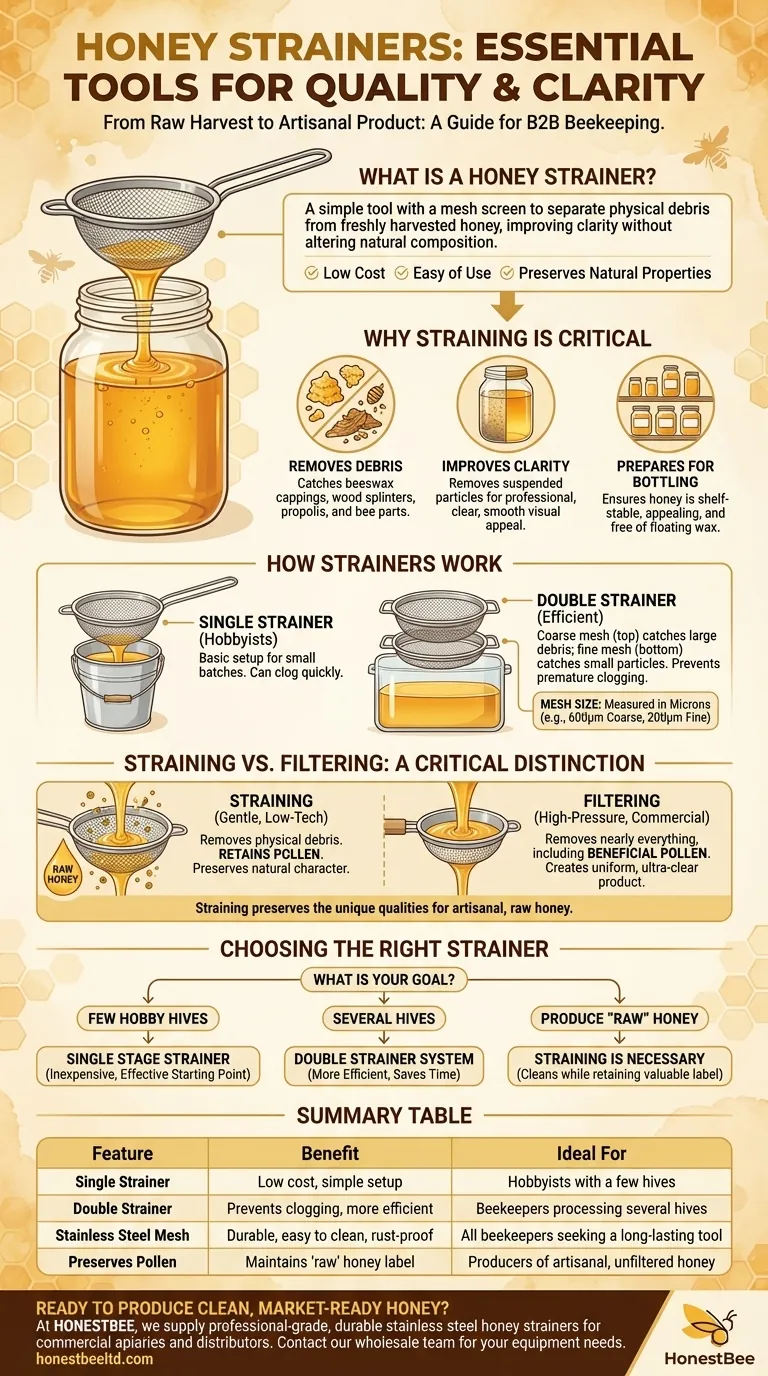In beekeeping, a honey strainer is a simple and essential tool featuring a mesh screen used to separate physical debris from freshly harvested honey. Its primary advantages are its low cost, ease of use, and effectiveness in improving the clarity and visual appeal of the final product without altering its natural composition. This makes it the ideal solution for hobbyists and small-scale beekeepers.
While raw honey is perfectly edible straight from the comb, it contains particles like wax and propolis. A honey strainer is the definitive tool for producing clean, clear, and marketable honey while preserving the beneficial properties that commercial filtering often removes.

Why Straining Honey is a Critical Step
Unprocessed honey contains more than just honey. The straining process is designed to remove visible impurities that are a natural byproduct of extraction, directly impacting the quality and consumer appeal of your final product.
Removing Extraction Debris
During harvest and extraction, it's inevitable that small particles get mixed into the honey. A strainer's primary job is to catch this debris, which typically includes beeswax cappings, wood splinters from frames, propolis, and occasionally bee parts.
Improving Clarity and Texture
Consumers associate high-quality honey with clarity and a smooth texture. Straining removes the suspended particles that make honey look cloudy or feel gritty, resulting in a visually appealing product that looks professional and clean in a jar.
Preparing Honey for Bottling
Before you can bottle and sell or gift your honey, it must be free of debris. Straining is the minimum required step to ensure your honey is shelf-stable and appealing, preventing bits of wax from floating to the top of the jar over time.
How Different Honey Strainers Work
While the principle is simple, strainers come in several configurations. The core mechanism involves pouring honey through a mesh screen, allowing gravity to do the work of separating the liquid from the solids.
The Single Strainer
This is the most basic setup, consisting of a single mesh screen that fits over a bucket or bottling tank. It is highly affordable and sufficient for very small batches, but it can clog quickly with wax and other debris.
The Double Strainer
A more efficient and common design, the double strainer, features two nested screens. The top strainer has a coarse mesh (larger holes) to catch large debris, while the bottom strainer has a finer mesh to catch smaller particles. This progressive system prevents the fine screen from clogging prematurely.
Materials and Mesh Size
Most quality strainers are made from stainless steel because it is durable, will not rust, and is easy to clean and sanitize. The mesh fineness is measured in microns; a coarser mesh might be 600 microns, while a finer one could be 200 microns.
Understanding the Trade-offs: Straining vs. Filtering
The terms "straining" and "filtering" are often used interchangeably, but they represent two very different processes with different outcomes. For a small-scale beekeeper, this distinction is critical.
The Goal of Straining
Straining is a gentle, low-tech process. Its purpose is to remove unwanted physical debris while leaving the honey's natural composition intact. Crucially, straining does not remove pollen, which is a key characteristic of raw, local honey.
The Goal of Filtering
Filtering, especially in large commercial operations, often involves high pressure and sometimes heat. It forces honey through extremely fine filters that strip out nearly everything, including beneficial microscopic pollen grains. This creates a crystal-clear, uniform product with a long shelf life but removes many of the unique properties of raw honey.
Why This Matters for Your Honey
As a small-scale beekeeper, the unique character and natural state of your honey are your greatest assets. By choosing to strain rather than filter, you are preserving the very qualities—like local pollen content—that make your honey a distinct, artisanal product.
Making the Right Choice for Your Goal
Selecting the right strainer depends on the scale of your operation and your end goal.
- If your primary focus is a few hobby hives: A simple, single-stage stainless steel strainer is an inexpensive and effective starting point.
- If your primary focus is processing several hives at once: A double-strainer system is far more efficient and will save you significant time and frustration.
- If your primary focus is producing "raw" or "unfiltered" honey: Straining is the correct and necessary process to clean your honey while legitimately retaining this valuable label.
Using a honey strainer is the foundational step in transforming your raw harvest into a high-quality, artisanal product you can be proud of.
Summary Table:
| Feature | Benefit | Ideal For |
|---|---|---|
| Single Strainer | Low cost, simple setup | Hobbyists with a few hives |
| Double Strainer | Prevents clogging, more efficient | Beekeepers processing several hives |
| Stainless Steel Mesh | Durable, easy to clean, rust-proof | All beekeepers seeking a long-lasting tool |
| Preserves Pollen | Maintains 'raw' honey label and beneficial properties | Producers of artisanal, unfiltered honey |
Ready to produce clean, market-ready honey?
At HONESTBEE, we supply professional-grade beekeeping supplies to commercial apiaries and equipment distributors. Our durable, stainless steel honey strainers are designed for efficiency and longevity, helping you maintain the high quality of your raw honey harvest.
Contact our wholesale team today to discuss your equipment needs and get a quote.
Visual Guide

Related Products
- HONESTBEE 72 Frame Industrial Electric Honey Extractor for Beekeeping
- Honey Concentrating Vacuum Heating Thickening Machine Dehumidifier for Honey
- 8-Frame Electric Self-Reversing Honey Extractor Spinner for Commercial Honey Extraction Equipment
- High Quality Honey Dehumidifier Dryer Thickening Machine for Beekeeping
- Professional Thermostatic Conical Honey Melter
People Also Ask
- How do automatic honey extractors function? Achieve High-Efficiency Honey Harvesting
- Can a manual extractor be upgraded to an electric one? Save Labor & Boost Efficiency
- What are the two common types of honey extractors? Choose the Right Extractor for Your Apiary
- What should a beekeeper do after extracting honey from supers? A Guide to Harvest Management
- What are the advantages of automatic honey extractors? Scale Your Apiary with Unmatched Efficiency



















